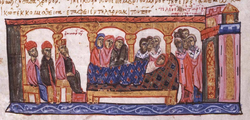Helena Lekapene
| Helena Lekapene | |
|---|---|
Romanos I | |
| Mother | Theodora |
| Religion | Chalcedonian Christianity |
Helena Lekapene (
Background
The deaths of Emperor Leo VI the Wise in 912 and his brother and successor Alexander in 913 left the throne of the Byzantine Empire to Constantine VII. Constantine was only seven years old when he assumed the throne. The empire was placed in the care of regents.
In 919, a coup d'état involving various factions managed to remove Zoe from power. The new effective regent was Romanos Lekapenos, Droungarios (admiral) of the Byzantine navy. Romanos orchestrated the marriage of Helena to Constantine VII as a way to secure a connection to the legitimate Macedonian dynasty.
Reign of Romanos
The work Theophanes Continuatus was a continuation of the chronicle of Theophanes the Confessor by other writers, active during the reign of her husband. The description of her marriage at the chronicle places the event in April or May 919. The groom was still four or five months short of his 14th birthday. The age of Helena is not recorded but she was likely also of minor age. They would not have children until the 930s.
Romanos was proclaimed basileopatōr ("father of the emperor") on the occasion of the marriage. In September, 920, Romanos was invested as kaisar (Caesar). On 17 December 920, Romanos was crowned co-emperor and in effect became the senior of the two associate emperors.
Helena now was married to the junior co-ruler. Her mother Theodora was crowned Augusta in January 921 and was her senior in palace hierarchy until her death on 20 February 922. Helena became in effect the senior co-empress of the palace following the death of her mother. Her brother
In 924, there was a senior emperor (Romanos), two junior emperors (Constantine VII and Christopher), and two empresses (Helena and Sophia). However Romanos crowned two more of his sons as co-emperors,
With the favor of Romanos, Christopher held seniority among the four junior co-emperors. He was the heir to the throne while Constantine VII, Stephen, and Constantine Lekapenos were to remain junior co-rulers. However Christopher died in 931. Romanos did not advance his younger sons in precedence over Constantine VII. His son-in-law was now the heir over his own sons. Helena was bound to become the principal empress upon the death of her father.
This period lasted until 16 December 944. Fearing that Romanos would allow Constantine VII to succeed him instead of them, his younger sons Stephen and Constantine arrested their father and took him to the
Reign of Constantine

Constantine VII was restored to his position as senior emperor after 24 years as junior co-ruler. On 27 January 945, his brothers-in-law and co-rulers Stephen and Constantine also were deposed. They were sent into exile, leaving Constantine VII sole emperor. Helena was by then the only empress. Having never exercised executive authority, Constantine remained primarily devoted to his scholarly pursuits and relegated his authority to bureaucrats and generals as well as his energetic wife Helena.
Romanos II was the co-ruler and heir. When Constantine VII died on 9 November 959, Romanos II succeeded him to the throne. His own wife Theophano convinced him to send all five of his sisters to the convent of Kanikleion. Helena seems to have retired from palace life after this point. Her death on 19 September 961 is among the last events recorded in the Theophanes Continuatus chronicle.

Issue
With Constantine VII:
- Leo, who died young.
- Romanos II.
- Zoe, sent to a convent.
- Theodora, who married Emperor John I Tzimiskes.
- Agatha, sent to a convent.
- Theophano, sent to a convent.
- Anna, sent to a convent.
References
- ^ Judith Herrin (2013). Unrivalled Influence: Women and Empire in Byzantium. Princeton University Press. P. 324.
- ^ Denis Sullivan, Elizabeth A. Fisher, Stratis Papaioannou. BRILL, 2011. Byzantine Religious Culture: Studies in Honor of Alice-Mary Talbot. P. 91. "Of the few references to women in the Synopsis, the story of Helen Lekapene the wife of Constantine VII (913–59) and daughter of Romanos I Lekapenos (920–44) falls in this category."
- ^ Anne Commire, Deborah Klezmer (1994). Historic World Leaders: Africa, Middle East, Asia, Pacific. Gale Research Incorporated.
